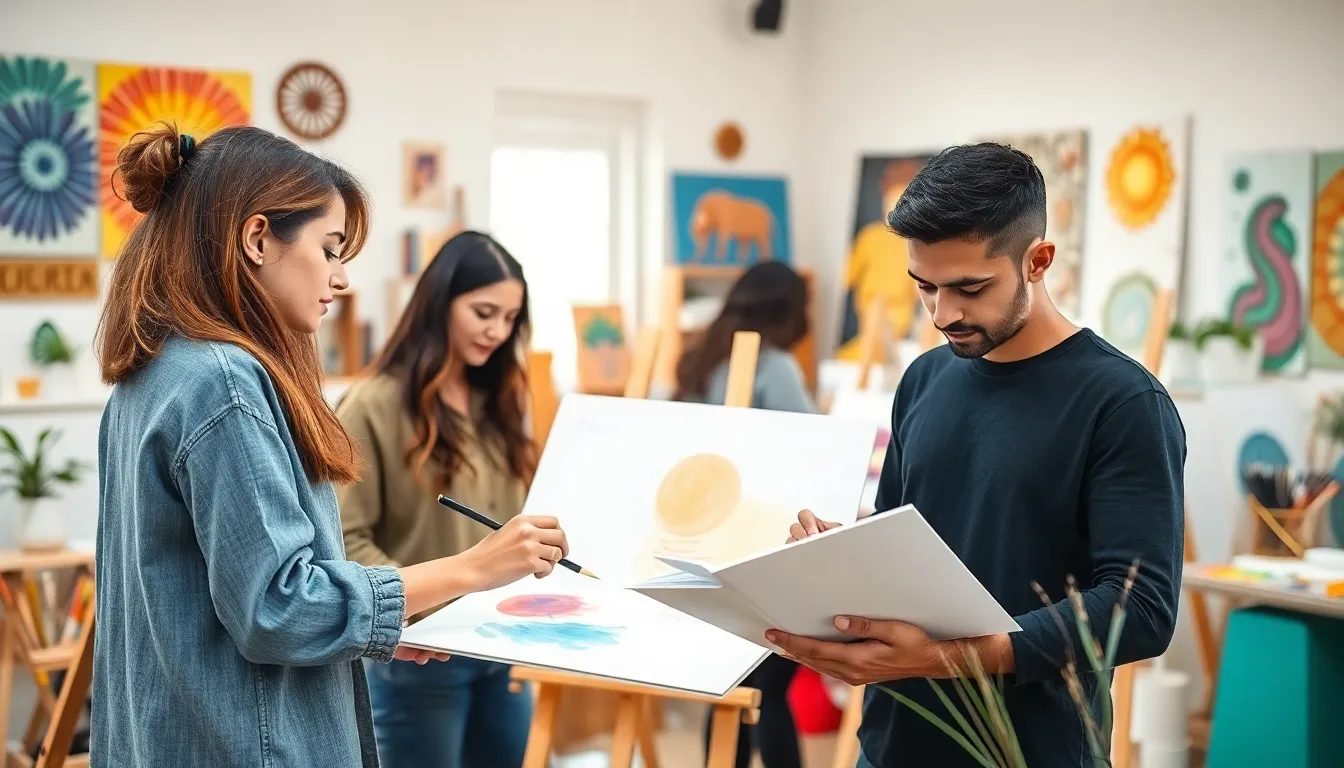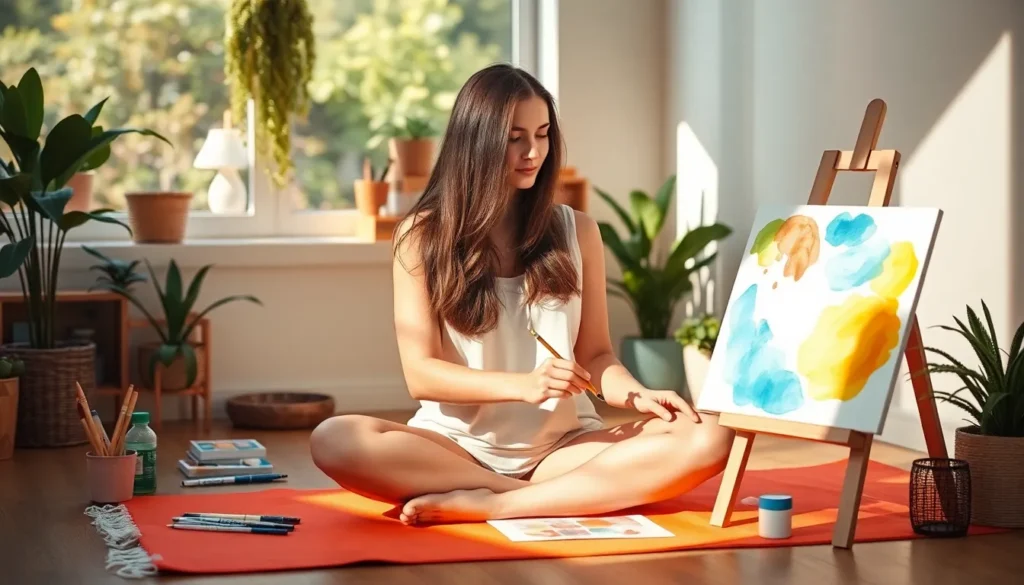In a world buzzing with distractions and endless to-do lists, mindfulness art emerges as a delightful escape. It’s not just about creating pretty pictures; it’s about diving into the present moment while wielding a paintbrush or doodling in a sketchbook. Imagine transforming your stress into vibrant colors and shapes, all while finding zen in the chaos of daily life.
Mindfulness art invites everyone—from the seasoned Picasso to the crayon-wielding novice—to tap into their creativity and discover the calming benefits of artistic expression. It’s like meditation, but with a splash of paint and a dash of fun. So grab those art supplies and get ready to unleash your inner artist while cultivating a serene mind. Who knew finding peace could be so colorful?
Mindfulness Art
Mindfulness art represents a creative approach to enhancing self-awareness. This practice combines artistic expression with mindfulness techniques, allowing individuals to focus on the present moment. Engaging in mindfulness art cultivates a deeper sense of tranquility and connection to oneself.
Creating art in this mindful manner does not require formal training. Individuals at any skill level can participate. The goal centers around expression rather than perfection, making art accessible to everyone.
Mindfulness art encourages participants to explore their emotions through various mediums. Some popular forms include painting, drawing, and sculpting. Each medium provides unique experiences, enabling artists to rediscover joy in creation.
This practice promotes relaxation similar to meditation. Artists often experience reduced stress and anxiety while immersed in their work. Fostering a routine that includes mindfulness art enhances mental clarity and emotional well-being.
Participants often find that indulging in these creative pursuits leads to improved focus. Regular engagement in mindfulness art aids in developing presence and awareness in everyday life. Trials show that integrating art therapy into daily routines contributes positively to overall mental health.
Mindfulness art serves as a reminder that creativity can transform one’s state of mind. Individuals can embrace personal expression while building a strong foundation for emotional stability. As this practice grows in popularity, more people discover the benefits it brings.
Benefits of Mindfulness Art

Mindfulness art offers significant benefits for both mental health and creative expression. Participants experience a variety of advantages that contribute to their overall well-being.
Enhancing Mental Well-Being
Engagement in mindfulness art leads to improvements in mental well-being. It effectively reduces symptoms of stress and anxiety, allowing individuals to achieve a state of relaxation. Practicing mindfulness through art fosters emotional awareness and self-reflection. When individuals create art, they often process emotions, which enhances clarity and reduces mental clutter. Studies show that creative activities release endorphins, contributing to feelings of happiness and peace. Individuals are encouraged to explore various mediums like painting and drawing, which facilitate personal expression and promote emotional stability.
Promoting Creativity
Mindfulness art acts as a catalyst for creativity. Embracing the creative process encourages individuals to break free from self-imposed limitations and explore their artistic abilities. Participants often discover new techniques and materials that invigorate their artistic practice. The non-judgmental essence of mindfulness art allows for uninhibited expression, enabling individuals to innovate without fear of failure. Engaging in this practice helps develop imaginative thinking and problem-solving skills, which translate into everyday situations. Ultimately, mindfulness art nurtures creative potential and inspires unique forms of self-expression.
Techniques in Mindfulness Art
Mindfulness art incorporates various techniques that foster creativity and self-awareness. Participants can choose from several mediums to express their thoughts and feelings, enhancing their mental well-being.
Painting and Drawing
Painting and drawing encourage exploration of colors and forms. Artists may focus on the sensations that arise while creating, allowing for a deeper connection to each stroke and hue. Emphasis on the process rather than the final product promotes relaxation. Watercolor, acrylics, and pastels are effective mediums that are often used. Simple guidelines can lead to profound experiences, as individuals learn to let go of perfectionism. Engaging with these techniques often brings about mindfulness, rooted in the enjoyment of movement and expression.
Sculpture and 3D Art
Sculpture and 3D art provide tactile experiences that ground creators in the present moment. Using materials like clay, wood, or metal, artists manipulate forms with their hands, encouraging a physical connection to their work. This technique emphasizes the importance of touch, enhancing the sensory experience. Creating three-dimensional pieces enables exploration of space and texture, allowing for unique forms of expression. Participants often find that working with their hands calms their minds, leading to moments of clarity and self-discovery. Articulating emotions through sculptural techniques fosters an imaginative exploration that transcends traditional methods.
Incorporating Mindfulness Art into Daily Life
Integrating mindfulness art into daily routines fosters creativity and presence. Adults and children alike can benefit from engaging in artistic practices that promote self-awareness and tranquility.
Setting Up a Mindfulness Art Space
Creating a dedicated mindfulness art space encourages focus and creativity. This area should be free from distractions, allowing for complete immersion in the artistic process. Using natural light enhances the experience and inspires the imagination. Including essential supplies, such as paints, brushes, and sketch pads, minimizes interruptions. Adding personal touches, like inspirational quotes or calming colors, establishes a welcoming environment. Individuals can design their spaces to reflect their personalities, making each session unique.
Guided Mindfulness Art Practices
Incorporating guided mindfulness art practices offers structure and support. Various resources, such as online tutorials or local workshops, provide excellent starting points. Techniques may include focused breathing exercises or themed prompts that help participants access emotions. Engaging in step-by-step activities encourages exploration and creativity, allowing individuals to let go of self-judgment. Participants often find that these practices enhance their artistic expression while deepening their connection to the present moment. Regular participation cultivates a routine that integrates mindfulness and art effortlessly.
Conclusion
Mindfulness art stands as a powerful tool for enhancing well-being and creativity. By immersing oneself in artistic expression, individuals can cultivate a deeper connection to the present moment. This practice not only reduces stress and anxiety but also promotes emotional clarity and self-awareness.
Creating a dedicated space for mindfulness art encourages focus and invites exploration. With the right techniques and resources, anyone can embark on this fulfilling journey. Embracing mindfulness art can transform daily life, making it a valuable addition to anyone’s routine.

